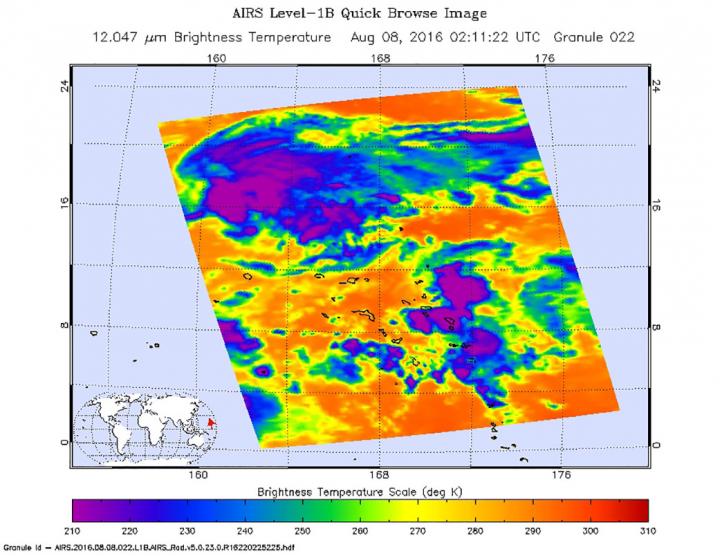NASA gets an infrared look at newly formed Tropical Depression 08W

The AIRS instrument aboard NASA's Aqua satellite looked at cloud top temperatures within Tropical Depression 08W on Aug. 7, 2016, at 10:11 p.m. EDT (Aug. 8 at 2:11 p.m. UTC). The purple color indicates the coldest cloud tops and strongest storms. Credit: NASA JPL, Ed Olsen
The Atmospheric Infrared Sounder or AIRS instrument aboard NASA's Aqua satellite used infrared data to look at cloud top temperatures within Tropical Depression 08W on Aug. 7 at 10:11 p.m. EDT (Aug. 8 at 2:11 a.m. UTC).
Forecasters at the Joint Typhoon Warning Center (JTWC) noted that animated enhanced infrared imagery “showed continued improvement in the convective structure (where thunderstorms are forming) with deep formative banding [of thunderstorms] wrapping into the low level circulation center.”
At 11 a.m. EDT (3 p.m. UTC) on Aug. 8, 2016, Tropical Depression 08W's maximum sustained winds were near 34.5 mph (30 knots/55.5 kph).
It was centered about 364 nautical miles west-southwest of Wake Island, near 17.9 degrees north latitude and 160.1 degrees east longitude. The depression was moving to the west-northwest at 4.6 mph (4 knots/7.4 kph).
The JTWC forecast calls for this storm to continue to intensify as it turns to the northwest through open waters of the Northwestern Pacific Ocean. The storm is expected to reach typhoon strength by Aug. 11.
Media Contact
All latest news from the category: Earth Sciences
Earth Sciences (also referred to as Geosciences), which deals with basic issues surrounding our planet, plays a vital role in the area of energy and raw materials supply.
Earth Sciences comprises subjects such as geology, geography, geological informatics, paleontology, mineralogy, petrography, crystallography, geophysics, geodesy, glaciology, cartography, photogrammetry, meteorology and seismology, early-warning systems, earthquake research and polar research.
Newest articles

Trotting robots reveal emergence of animal gait transitions
A four-legged robot trained with machine learning by EPFL researchers has learned to avoid falls by spontaneously switching between walking, trotting, and pronking – a milestone for roboticists as well…

Innovation promises to prevent power pole-top fires
Engineers in Australia have found a new way to make power-pole insulators resistant to fire and electrical sparking, promising to prevent dangerous pole-top fires and reduce blackouts. Pole-top fires pose…

Possible alternative to antibiotics produced by bacteria
Antibacterial substance from staphylococci discovered with new mechanism of action against natural competitors. Many bacteria produce substances to gain an advantage over competitors in their highly competitive natural environment. Researchers…





















